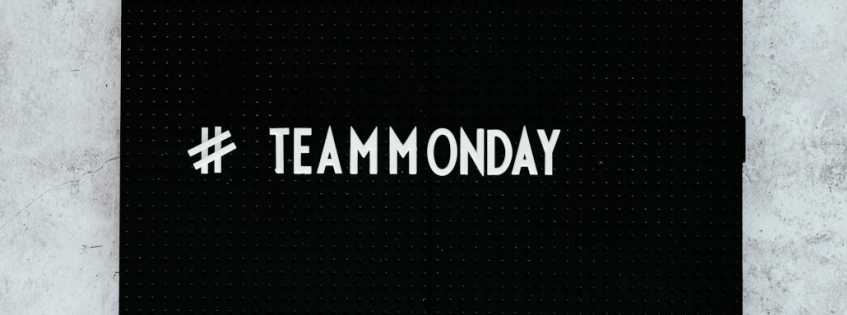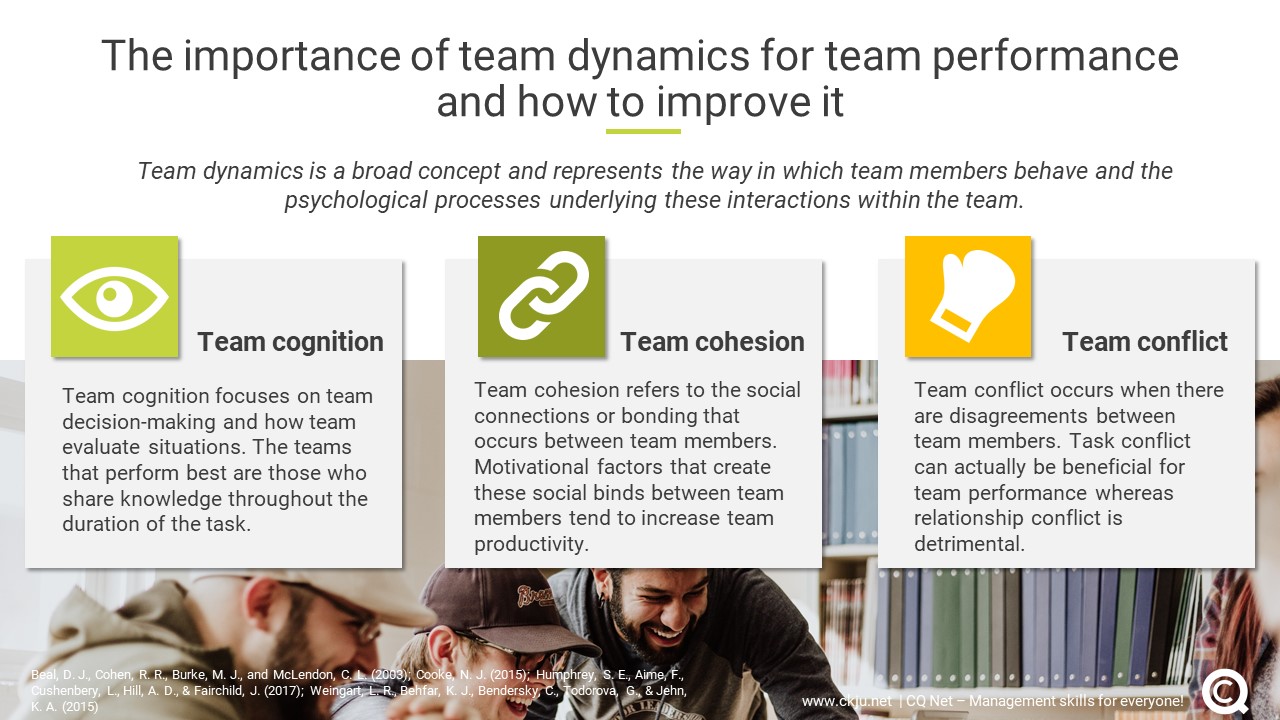- All Management Learning Resources
- Team dynamics

Executive summary
In this CQ Dossier we focus on team dynamics and how they influence team behaviors and team performance. Team dynamics are unconscious psychological forces that affect how team members interact and work together on tasks and projects. First, we describe team dynamics and focus on several dimensions of team dynamics – team cohesion, team cognition, and team conflict. Second, we focus on the relationship between team dynamics, and team performance. Finally, we provide recommendations in this CQ dossier how you can best to harness team dynamics in your organization.
Contents
- Executive summary
- What are team dynamics?
- Team dynamics originates from the concept of groups dynamics
- Team cognition, cohesion and conflict are important dimensions of team dynamics
- What is the relationship between team dynamics and team performance?
- Task conflict increases performance whereas relationship conflict decreases performance
- How to harness team dynamics: Focus on relationship-building between team members
- Critical appraisal of team dynamics: Solidity Level 4
- Key take-aways
- References and further reading
What are team dynamics?
Team dynamics is a broad concept and represents the way in which team members behave and the psychological processes underlying these interactions within the team. When team members engage in work projects, their behaviors are interdependent and from these interactions, there is a team emergence of attitudes, motivation, and cognition that influence how team members feel about each other, their team, and team projects. This constellation of affect, attitude and behaviors represent team dynamics and are the foundation for team work (Bell, Brown, Colaneri & Outland, 2018; Salas, Cooke & Rosen, 2008).
Team dynamics originates from the concept of groups dynamics
The research on team dynamics or team processes originates from the concept of groups dynamics and the Gestalt notion that the ‘whole is greater than the sum of its parts.’ The social psychologist, Kurt Lewins, conducted research on the interaction between individuals and considered group dynamics to describe both the positive and negative forces within a group (Dion 2000).
Team cognition, cohesion and conflict are important dimensions of team dynamics
Over the past decade, a wealth of research has focused on the importance of team dynamics in predicting team performance. Several key dimensions have emerged in this body of research. Because the area of team dynamics is broad, this dossier focuses on several key team dynamics:
- team cognition,
- team cohesion, and
- team conflict.
Although this list does not encompass all aspects of team dynamics, researchers have focused on these three because of their importance in effective team work.
Team cognition
Team cognition focuses on team decision-making and how team evaluate situations (Cooke, Gorman & Winner, 2007). Most research on cognition focused on individual decision-making and information processing.
Moreover, team cognition has previously been linked to individual knowledge and how this knowledge is distributed across team members (Cooke et al., 2007). However, interactive team cognition theory proposes that cognition resides in team interactions (Cooke et al., 2007).
A management concept that is closely related to team cognition is team mental models (TMM). The key theme behind team mental models is the requirement to have team members "on the same page". There is plenty of empirical research available about TMMs and how to utilize this concept to increase team performance.
Management skills newsletter
Join our monthly newsletter to receive management tips, tricks and insights directly into your inbox!
Team cohesion
Team cohesion refers to the social connections or bonding that occurs between team members. Motivational factors that create these social binds between team members tend to increase team productivity (Beale et al., 2003).
Team conflict
Team conflict occurs when there are disagreements between team members in terms of both disagreements concerning tasks and also conflict within relationships between team members (Weingart et al., 2015).
Task conflict occurs when there is disagreement about the content of tasks and relationship conflict occurs when there is a clash of values between team members. The research suggests that task conflict can actually be beneficial for team performance whereas relationship conflict is detrimental.
What is the relationship between team dynamics and team performance?
Research on team dynamics and team performance show that team processes matter and influence team performance.
Explicit communication leads to team cognition which increases team performance
Nancy Cooke and her colleagues have conducted research on team cognition and have shown that cognitive processes within a team impact team behaviors and team performance (Cooke, 2015). In a review of the research, Cooke (2015) describes how the process of team cognition evolves from interactions between team members. These interactions frequently occur in explicit communications and lead to team cognition (Cooke, 2015).
A series of studies conducted by Cooke and colleagues in the laboratory show support for the theory of interactive team cognition. The teams that perform best are those who share knowledge throughout the duration of the task and these explicit communications lead to effective team performance (Cooke, 2015).
Team cohesion is positively related to team efficiency outcomes
There has been considerable research on team cohesion and performance that has mainly focused on factors that influence team cohesion, leading to specific team behaviors that enhance performance (Beale et al., 2003).
In a meta-analytic review, Beale and colleagues examined the influence of components of cohesion (interpersonal attraction, task commitment, group pride) on performance criteria and found cohesion within teams led to team performance.
Their findings revealed there was a significant relationship between cohesion and team performance when performance was defined as behavior rather than performance outcomes (Beale et al., 2003). The relationship was also positive when there was a focus on efficiency outcomes and when workflow became more intense.
Efficiency includes inputs as well as outputs whereas performance effectiveness just focuses on output such as sales within a store. This meta-analysis supports the proposition that team cohesion is important for team and organizational functioning (Beale et al., 2003).
Task conflict increases performance whereas relationship conflict decreases performance
Team conflict can be both detrimental and beneficial for team performance depending on the type of conflict (Weingart et al., 2015). In a study of 219 individuals who consisted 458 dyads within 51 teams, Humphrey and colleagues (2017) found that relationship conflict within a single dyad thwarts the exchange of information.
In contrast, information exchange in teams unlocked task conflict and this resulted in a positive relationship with performance over time. This research shows that conflict can be beneficial when there is a focus on tasks whereas relationship conflict acts as a negative force.
How to harness team dynamics: Focus on relationship-building between team members
The research on team dynamics shows that it is important for organizations to recognize the importance of team interactions. Although individual knowledge is important, it is not enough to foster effective team work.
Most important is relationship-building between team members. In research on team cohesion, cognition, and conflict, the worst-performing teams were those whose team members clashed in their interactions and conversations.
Organizations can introduce training interventions that equip employees with interpersonal skills that focus on being an effective team member. During hiring, employers can also include teamwork competencies as a requisite for selection.
In conclusion, the research on teamwork shows the importance of team dynamics and how unconscious psychological forces can impact how team members work together. In particular, the research shows that team interactions are the main ingredient for successful team collaborations whereby team members use effective communication to complete tasks.
Critical appraisal of team dynamics: Solidity Level 4
Based on the empirical evidence for the importance of team cohesion, this dossier is assigned a Level 4 rating, (Based on a 1- 5 measurement scale). A level 4 is the second highest rating score for a CQ Dossier based on the evidence provided on the efficacy of team dynamics. To date, the research on team dynamics has demonstrated the importance of this construct in predicting performance.
The findings show that team dynamics such as cognition, cohesion, and team conflict are important factors in determining how successfully teams perform. More research is needed on the importance of context particularly when teams work in hazardous situations (Bell et al., 2018).
Key take-aways
- Team dynamics represents the way in which team members behave
- The constellation of team attitudes, motivation, and cognition is the foundation for team work
- Interactive team cognition theory proposes that cognition resides in team interactions
- Team cohesion refers to social connections or bonding between team members
- Team conflict occurs when there are disagreements between team members based on task or relationships
- The research shows that team dynamics matter and influence team performance
References and further reading
Beal, D. J., Cohen, R. R., Burke, M. J., and McLendon, C. L. (2003). Cohesion and performance in groups: a meta-analytic clarification of construct relations. Journal of Applied Psychology, 88, 989–1004.
Bell, S. T., Brown, S. G., Colaneri, A., & Outland, N. (2018). Team composition and the ABCs of teamwork. American Psychologist, 73, 349–362.
Cooke, N. J. (2015). Team Cognition as Interaction. Current Directions in Psychological Science, 24, 6, 415–419.
Cooke, N. J., Gorman, J. C., & Winner, J. L. (2007). Team cognition. In F. T. Durso, R. S. Nickerson, S. T. Dumais, S. Lewandowsky, & T. J. Perfect (Eds.), Handbook of applied cognition (pp. 239-268). Hoboken, NJ, US: John Wiley & Sons Inc.
Dion, K. L. (2000). "Group cohesion: From "field of forces" to multidimensional construct". Group Dynamics: Theory, Research, and Practice. 4: 7–26.
Humphrey, S. E., Aime, F., Cushenbery, L., Hill, A. D., & Fairchild, J. (2017). Team conflict dynamics: Implications of a dyadic view of conflict for team performance. Organizational Behavior and Human Decision Processes, 142, 58-70.
Salas, E., Cooke, N. J., & Rosen, M. A. (2008). On teams, teamwork, and team performance: Discoveries and developments. Human Factors, 50, 540–547.
Weingart, L. R., Behfar, K. J., Bendersky, C., Todorova, G., & Jehn, K. A. (2015). The directness and oppositional intensity of conflict expression. Academy of Management Review, 40, 235–262.
About the Author






